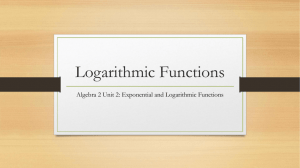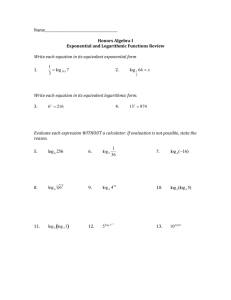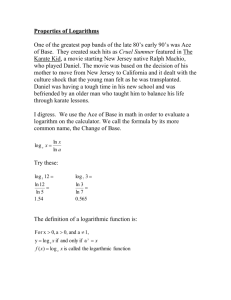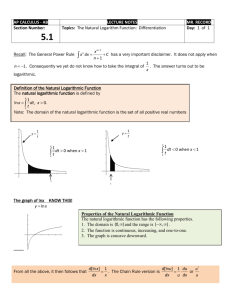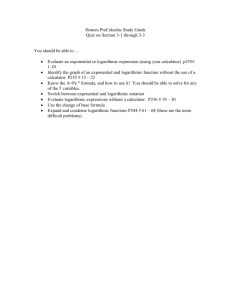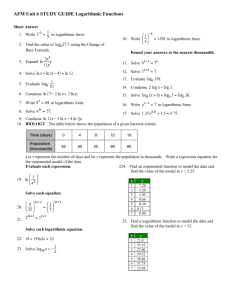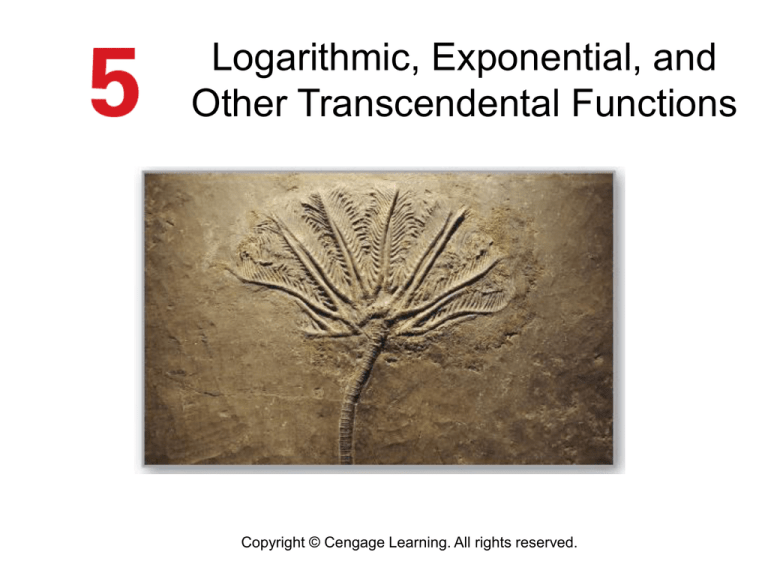
Logarithmic, Exponential, and
Other Transcendental Functions
Copyright © Cengage Learning. All rights reserved.
The Natural Logarithmic
Function: Differentiation
Copyright © Cengage Learning. All rights reserved.
Objectives
Develop and use properties of the natural logarithmic
function.
Understand the definition of the number e.
Find derivatives of functions involving the natural
logarithmic function.
3
The Natural Logarithmic Function
4
The Natural Logarithmic Function
The General Power Rule
has an important disclaimer—it doesn’t apply when
n = –1. Consequently, you have not yet found an
antiderivative for the function f(x) = 1/x.
In this section, you will use the Second Fundamental
Theorem of Calculus to define such a function.
This antiderivative is a function that you have not
encountered previously in the text.
5
The Natural Logarithmic Function
It is neither algebraic nor trigonometric, but falls into a new
class of functions called logarithmic functions.
This particular function is the natural logarithmic function.
6
The Natural Logarithmic Function
7
The Natural Logarithmic Function
From this definition, you can see that ln x is positive for
x > 1 and negative for 0 < x < 1, as shown in Figure 5.1.
Moreover, ln(1) = 0, because the upper and lower limits of
integration are equal when x = 1.
Figure 5.1
8
The Natural Logarithmic Function
To sketch the graph of y = ln x, you can think of the natural
logarithmic function as an antiderivative given by the
differential equation
Figure 5.2 is a computer-generated
graph, called a slope (or direction)
field, showing small line segments
of slope 1/x.
The graph of y = ln x is the solution
that passes through the point (1, 0).
Figure 5.2
9
The Natural Logarithmic Function
The next theorem lists some basic properties of the
natural logarithmic function.
10
The Natural Logarithmic Function
Using the definition of the natural logarithmic function, you
can prove several important properties involving operations
with natural logarithms. If you are already familiar with
logarithms, you will recognize that these properties are
characteristic of all logarithms.
11
Example 1 – Expanding Logarithmic Expressions
12
Example 1 – Expanding Logarithmic Expressions cont’d
13
The Natural Logarithmic Function
When using the properties of logarithms to rewrite
logarithmic functions, you must check to see whether the
domain of the rewritten function is the same as the domain
of the original.
For instance, the domain of f(x) = ln x2
is all real numbers except x = 0, and
the domain of g(x) = 2 ln x is all
positive real numbers. (See Figure 5.4.)
Figure 5.4
14
The Number e
15
The Number e
It is likely that you have studied logarithms in an algebra
course. There, without the benefit of calculus, logarithms
would have been defined in terms of a base number.
For example, common logarithms have a base of 10 and
therefore log1010 = 1.
The base for the natural logarithm is defined using the
fact that the natural logarithmic function is continuous, is
one-to-one, and has a range of (
, ).
16
The Number e
So, there must be a unique
real number x such that lnx = 1,
as shown in Figure 5.5.
This number is denoted by the
letter e. It can be shown that e is
irrational and has the following
decimal approximation.
Figure 5.5
17
The Number e
Once you know that ln e = 1, you can use logarithmic
properties to evaluate the natural logarithms of several
other numbers.
18
The Number e
For example, by using the property
ln(en) = n ln e
= n(1)
=n
you can evaluate ln (en) for various values of n as shown
in the table and in Figure 5.6.
Figure 5.6
19
The Number e
The logarithms shown in the table are convenient because
the x–values are integer powers of e. Most logarithmic
functions are, however, best evaluated with a calculator.
20
Example 2 – Evaluating Natural Logarithmic Expressions
21
The Derivative of the Natural
Logarithmic Function
22
The Derivative of the Natural Logarithmic Function
The derivative of the natural logarithmic function is given in
Theorem 5.3.
The first part of the theorem follows from the definition of
the natural logarithmic function as an antiderivative.
The second part of the theorem is simply the Chain Rule
version of the first part.
23
The Derivative of the Natural Logarithmic Function
24
Example 3 – Differentiation of Logarithmic Functions
25
The Derivative of the Natural Logarithmic Function
On occasion, ot is convenient to use logarithms as aids in
differentiating nonlogarithmic functions.
This procedure is called logarithmic differentiation.
26
Example 6 – Logarithmic Differentiation
Find the derivative of
Solution:
Note that y > 0 for all x ≠ 2. So, ln y is defined.
Begin by taking the natural logarithm of each side of the
equation.
Then apply logarithmic properties and differentiate
implicitly. Finally, solve for y'.
27
Example 6 – Solution
cont’d
28
The Derivative of the Natural Logarithmic Function
Because the natural logarithm is undefined for negative
numbers, you will often encounter expressions of the form
The next theorem states that you can differentiate
functions of the form
as though the absolute value
notation was not present.
29
Example 7 – Derivative Involving Absolute Value
Find the derivative of
f(x) = ln |cosx |.
Solution:
Using Theorem 5.4, let u = cos x and write
30


